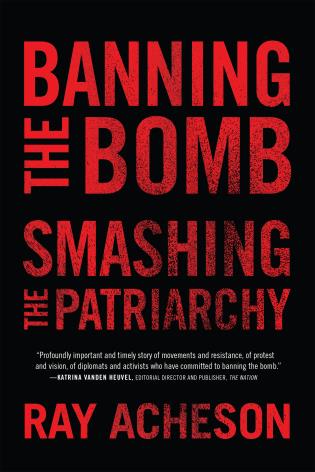With this book, Ray Acheson guides us through the collaborative processes that brought about the 2016 UN Treaty for the Prohibition of Nuclear Weapons (TPNW), the first legally-binding international agreement to comprehensively prohibit nuclear weapons. Acheson is director of Reaching Critical Will, the disarmament programme of the Women’s International League for Peace and Freedom (WILPF).
Drawing on their own observations and feminist analysis, Acheson recounts how the parties involved developed a new approach to international relations – one that would break free from the previous anti-nuclear treaties and would result in the UN general assembly outlawing nuclear weapons.
In the opening chapter, Acheson outlines the challenges facing nuclear disarmament campaigners, including an excellent, scholarly explanation of the ‘bloated’ economy of nuclear weapons. They also help us to see how justifications offered for nuclear weapons by major states are based on colonial racism, idolising nuclear weapons as expressions of power, and patriarchal notions of security.
Those who perpetuate these arguments for their own ends like to dismiss concerns about the humanitarian consequences of the Bomb as ‘feminine’, meaning weak and irrational.
The eventual participants in the negotiations for the ban treaty were diplomats from non-nuclear-weapon states, international organisations such as the Red Cross, and NGOs such as WILPF.
At the 2013 review of the Treaty on the Non-Proliferation of Nuclear Weapons (NPT) these groups successfully lobbied for the inclusion of clauses on the devastating humanitarian and environmental costs of nuclear weapons. They then recognised there was a need for a new treaty – one that the nuclear-armed states couldn’t just pretend to honour.
After the failure of the 2013 Conference on Disarmament, activists realised they had to form a space where smaller countries that had protested since the beginning, such as South Pacific islanders and indigenous people, would be listened to. They drew from lessons in feminist organising, from LGBT activism, and from previous campaigns that had led to bans on cluster munitions (2008) and on land mines (1997).
In their conclusion, Acheson writes that the TPNW is not intended to create a mass movement, but instead sees anti-nuclear campaigning as part of the broader contemporary anti-colonialist and anti-capitalist movements.
As a citizen of a nuclear-armed state myself, it is encouraging and inspiring to learn how it is possible to bring international pressure on governments, including my own, to give up the myth that nuclear weapons grant security.
Already we are seeing the results of the TPNW, with recent reports that the amount of funding available for the nuclear weapons industry has fallen by $63 billion and that more financial institutions are refusing to invest.


